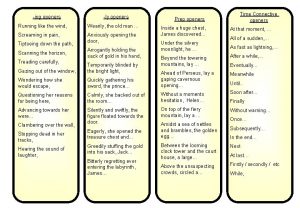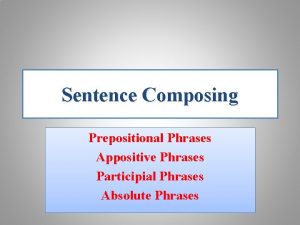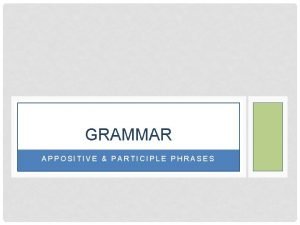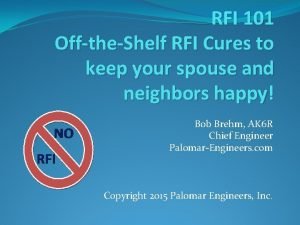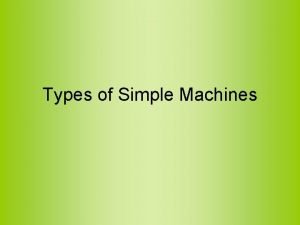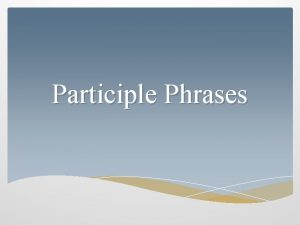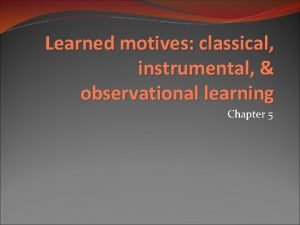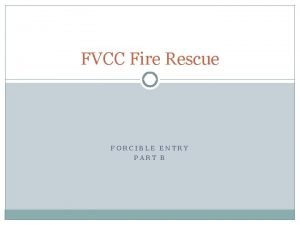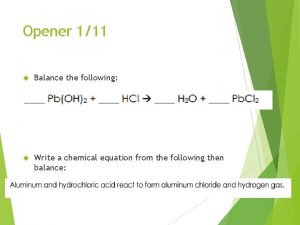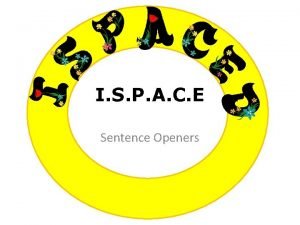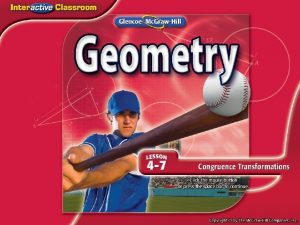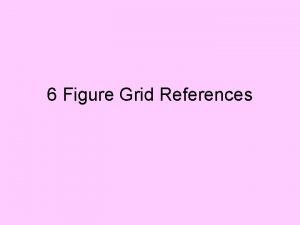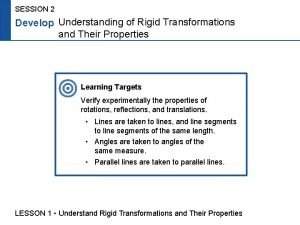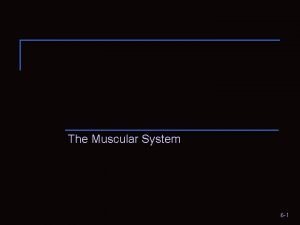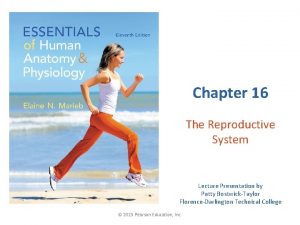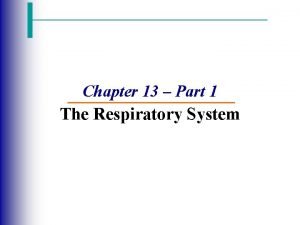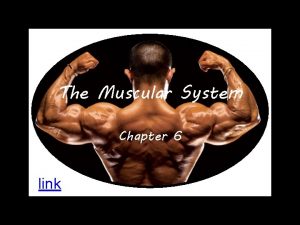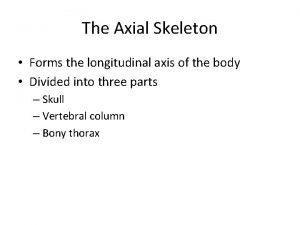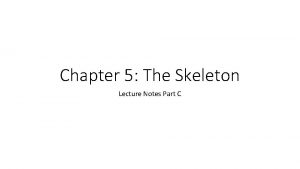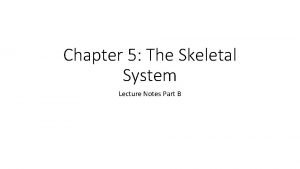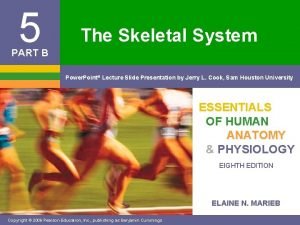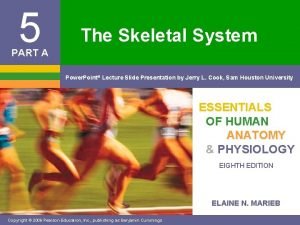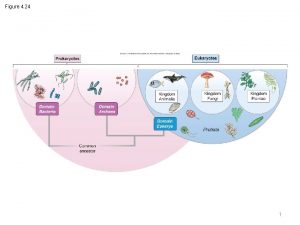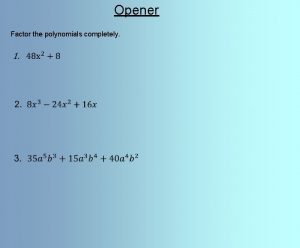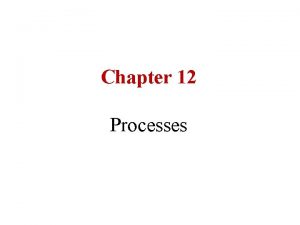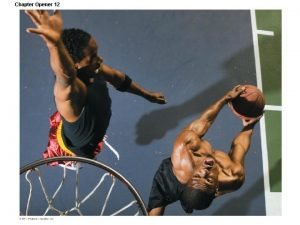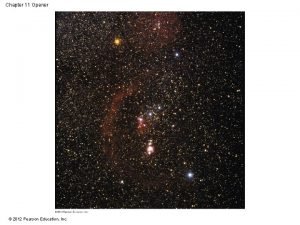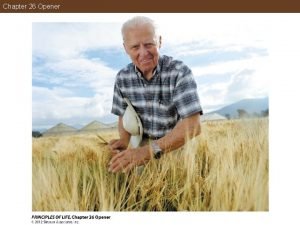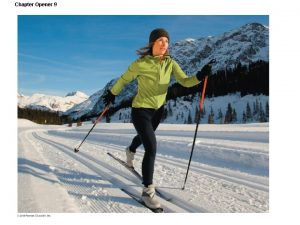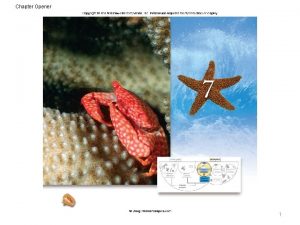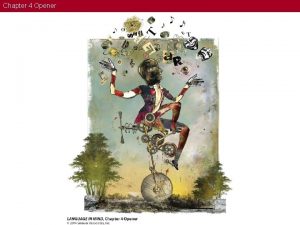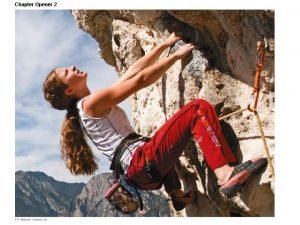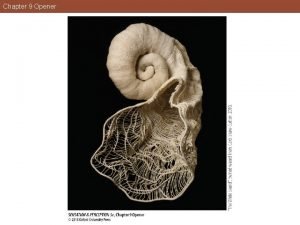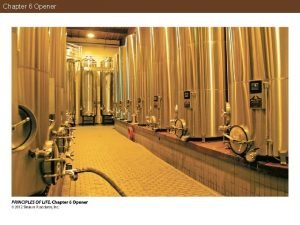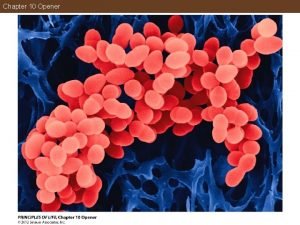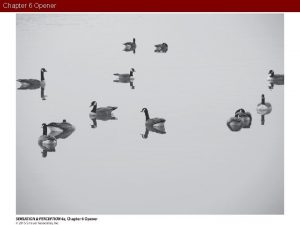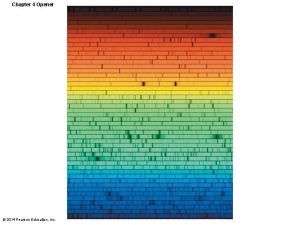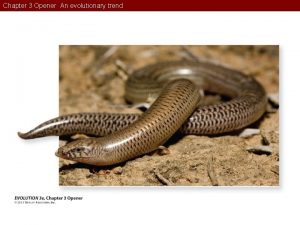Figure 4 24 1 Chapter Opener 2 Figure











































- Slides: 43

Figure 4. 24 1

Chapter Opener 2

Figure 7. 54 3

Characteristics of Major Animal Phyla 4

Chapter 7 Marine Animals Without a Backbone 무척추동물 5 Copyright © The Mc. Graw-Hill Companies, Inc. Permission required for reproduction or display.

Invertebrates 무척추동물 • Animals without a backbone are known as invertebrates무척추동물. • Those with a backbone 척추 are called vertebrates. 척추동물 • About 97% of animals are invertebrates. All major animal groups have representatives in the marine community. • Several animal groups are exclusively marine. 6

General Characteristics of Animals • Multicellular, diploid organisms with tissues, organs or organ systems in most • Heterotrophic • Require oxygen for aerobic respiration • Reproduce sexually, or asexually, or both • Most are motile at least during some portion of the life cycle • Animal life cycles include a period of embryonic development 7

General Characteristics of Animals • Basic body structure: – Symmetry (body plan) • Radial - round; equal parts radiate out from a central point (ex: sea star) 방사대칭 • Bilateral - organism can be divided into right and left halves that are more or less equal (ex: marine mammals) 좌우대칭 • Asymmetry - having no symmetry (ex: sponge) 비 대칭 8

Major Phyla of Marine Invertebrates Sponges 해면동물문 Porifera Cnidarians 자포동물문 Nematophora Comb-jelly 빗해파리문 Ctenophora Flatworms 편형동물문 Platyhelminthes Ribbon worms 유형동물문 Nemertea Nematodes 선형동물문 Nematoda Annelids 환형동물문 Annelida Sipunculans 성구동물문 Echiurans 의충동물문 Echiura Molluscs 연체동물문 Mollusca Arthropods 절지동물문 Arthropoda Bryozoans 내항동물문 Ectoprocta Phoronids 추형동물문 Phoronida Brachiopods 완족동물문 Brachiopoda Arrow worms 모악동물문 Chaetognatha Echinoderms 극피동물문 Echinodermata Hemichordates 반삭동물문 Hemichordata Tunicates 피낭류 미삭동물아문 Urochordata Lancelets 두삭동물아문 Cephalochordata 9

Invertebrates – Porifera 해면동물 • Porifera 해면동물문: The Sponges • Characteristics of Phylum: – All sponges are sessile (non-motile and living attached) and some encrust on hard substrate. – Numerous tiny pores (ostia 소공) exist in the body to allow water to pass through the sponge. (osculum 대공) – This water movement is required to allow sponges to filter feed (a type of suspension feeding) on plankton and dissolved organic matter in the water. 현탁물섭식 – Water flow is also essential to carry metabolites (waste) away from cells and to carry gametes. – A diagram of two typical sponge body plans is shown in Fig. 7. 1, pg. 116. 10

Invertebrates - Porifera • Porifera 해면동물문: The Sponges • Characteristics of Phylum: – – – Asymmetric body with no true tissues or organs. Mostly marine Varying size, shape, and color Solitary or colonial Regeneration capability Filter feeders 여과섭식자 해면동물은 다세포 동물 중에서 가장 간단한 구조이며, 진전한 조 직이나 기관이 없다. 대부분이 바다에서 부착성 여과 섭식자로 살 아간다. 11


Invertebrates - Porifera: The Sponges Types of Cells: Choanocytes (or collar cells) 깃세포(금세포) • • • line interior canals of the body; flagella on the choanocytes create a water current that brings more food particles into the body “Collars” on choanocytes traps food particles. Pinacocytes - these flattened cells cover exterior of body 편평세포 Porocytes - cells with a pore to allow water to pass into body 소공세포 13


Invertebrates - Porifera • Porifera: The Sponges – Structural support: • Spongin is a support protein 해면질 • Spicules are support structures made of silica or calcium carbonate. 골편 • These spicules have a variety of shapes from simple rods to star-shaped – 아메바성세포 amebocyte 15

Invertebrates - Porifera • Porifera: The Sponges • Modes of Reproduction – – Asexual budding- fragmentation of a cluster of cells from original sponge can begin growth in a new area. – Sexual- sperm are released into surrounding water (broadcast spawners 광역산란, ) to be picked up by a nearby sponge and directed to egg. – 생식소(gonad) – Most sponges are hermaphroditic (possess male and female reproductive parts). 자웅동체 암수한몸 – 중실유생 parenchymula 부유유생 – 변태 metamorphosis 16

Figure 7. 2 17


Sexually- amoebocytes differentiate into egg cells or sperm cells They are fertilized to produce a zygote The cell divides by mitosis Becomes a hollow sphere called a blastula Mobile Laval Stage Then it grows flagellum and us an amphiblastula stage Through metamorphosis settles down The flagellum develop in to collar cells hermaphrodite - an animal in which each adult can act as either the female or the male in reproduction 19


Figure 7. 5 b 피복해면동물 Encrusting sponge 21

Figure 7. 5 c 골해면 Sclerosponge 22

• • 피복해면동물 encrusting sponge 유리해면 Glass sponge 천공해면 Boring sponge 골해면 Sclerosponges sponge 산호해면 Corallin sponge 목욕해면 천연물자원 - 유용화학물질 23


Invertebrates - Cnidarians • Cnidaria 자포동물문: • Characteristics of Phylum: Stinging animals – Radial symmetry 방사대칭 (구면 oral surface, 반구면 aboral surface); Mostly marine, about 10, 000 species known – Two body forms exist : • Medusa – free floating form which is transported by water currents, mouth with surrounding tentacles are positioned downward 메두사 (해파리) • Polyp – sessile, attached form with mouth and tentacles are positioned upward 폴립 – Two tissue layers are present • Epidermis covers body surface 표피 • Gastrodermis lines internal body cavity and is specialized for digestion 위층 • Mesoglea 중교 25


Invertebrates - Cnidarians • Characteristics of Phylum: – Tentacle 촉수; Gut 위수강 – Cnidocytes (자세포 stinging cells) with nematocyst ( 자포) capsules located on tentacles. These are used for protection and for feeding – Digestive system is incomplete • sac-like with mouth only • 세포외소화 (extracellular digestion) 위수강 내 소화 • 세포내소화 (intracellular digestion) 위수강벽 세포 내 분해 – Nerve net throughout body coordinates movements • 신경세포 nerve cell; 신경망 nerve net • 평형포 statyocyst 석회질, 감각모 – Some jellyfish also have sensory cells and contractile cells 27

Invertebrates - Cnidarians Reproduction in Cnidarians: • Sexual – Medusa is normally the sexual stage with epidermal gonads – eggs and sperm released from medusa – Fertilized egg results in zygote – Zygotes develops into a swimming larva called a planula 플라눌라유생 – Planula “settles” on bottom to form colony – Eventually, new medusa are formed by this mature colony • Asexual – Polyps normally reproduce by budding 28

Invertebrates - Cnidarians • Classification of Cnidarians – Class Hydrozoa 히드로충강 – Class Scyphozoa 해파리강 – Class Anthozoa 산호충강 1. Class Scyphozoa 해파리강 – True Jellyfish – Free swimming large medusa forms with polyp only in reproductive life – All marine – They move by rhythmic contractions, but cannot fight against prevailing water currents – Many with powerful stings 29

Invertebrates - Cnidarians 2. Class Anthozoa 산호충강 Corals 산호, Anemones 말미잘, Sea Fans/Whips, Sea Pansy – Colonial polyps that normally lack a medusa stage – Corals secrete calcium carbonate “shells” – Most coral species possess symbiotic algae within body tissues called zooxanthellae 황록공생조류 – All marine – 산호초 – 해양목 Gorgonians, 붉은산호 precious coral, 흑산호 black coral 30


Invertebrates - Cnidarians 3. Class Hydrozoa 히드로충강 – Mostly polyp forms with reproductive medusa – Physalia is unusual species with a colony of polyps carried by a gas-filled float – Freshwater and marine species 32

Invertebrates - Cnidarians 히드로충 Macrorhynchia philipina 33


Invertebrates - Cnidarians 관해파리 siphonophore 뜸통 외피 자세포 내부(자포) 촉수 방출된 자포 방출 준비된 자포 중교 Physalia physalis Portugese man-of-war 35

Invertebrates – Cnidarians 해파리 메두사 Figure 7. 10 붉은 쐐기해파리 Chrysaora quinquecirrha 36


Page 122 입방해파리목 Chiropsalmus 쏘인 상처 38

Invertebrates - Ctenophores • Ctenophora 빗해파리문 – aka comb jellies • Characteristics of Phylum: – About 100 species, all marine – 8 rows of thick cilia that beat continuously – No nematocysts unless they harbor some from eating cnidarians – Long sticky tentacles used to capture prey • 교포 colloblast – Most species are planktonic – Can be found in warm and cold waters 39

Figure 7. 12 Mnemiopsis leidyi 섬모 빗판 40

Characteristics of Major Animal Phyla 41

Figure 7. 54 Tissue (조직) Symmetry (대칭) Body cavity (체강) Segmentation (체절) Lophophore (촉수관) Gill slits (새열) Notochord (척삭) 42

http: //www. ucmp. berkeley. edu/cnidariasy. html http: //en. wikipedia. org/wiki/Cnidaria 43
 Varied sentence starters
Varied sentence starters Appositive sentence opener
Appositive sentence opener Sentence openers
Sentence openers Adverb opener examples
Adverb opener examples Prepositional phrase opener
Prepositional phrase opener Whats a appositive phrase
Whats a appositive phrase Rfi vs rfp
Rfi vs rfp Complex sentence starters
Complex sentence starters Picture of third class lever
Picture of third class lever What's a participle
What's a participle Can opener
Can opener Forcible door entry device factory
Forcible door entry device factory Balance opener
Balance opener Ispace sentences
Ispace sentences Gulliver garage door repair
Gulliver garage door repair A transformation is an operation that
A transformation is an operation that 6 figure grid reference
6 figure grid reference Abcye
Abcye Is a trapezoid a plane figure
Is a trapezoid a plane figure Chapter 6 the muscular system figure 6-9
Chapter 6 the muscular system figure 6-9 Chapter 16 the reproductive system figure 16-2
Chapter 16 the reproductive system figure 16-2 Kidney pyramid labeled
Kidney pyramid labeled Chapter 13 respiratory system worksheet
Chapter 13 respiratory system worksheet Figure 11-8 arteries
Figure 11-8 arteries Chapter 11 the cardiovascular system figure 11-3
Chapter 11 the cardiovascular system figure 11-3 Chapter 6 the muscular system figure 6-9
Chapter 6 the muscular system figure 6-9 Chapter 5 skeletal system figure 5-13
Chapter 5 skeletal system figure 5-13 Contractile unit of muscle
Contractile unit of muscle The axial skeleton forms the longitudinal axis of the body
The axial skeleton forms the longitudinal axis of the body Typical vertebra superior view
Typical vertebra superior view Chapter 5 the skeletal system figure 5-10
Chapter 5 the skeletal system figure 5-10 Chapter 3 cells and tissues figure 3-7
Chapter 3 cells and tissues figure 3-7 Chapter 3 cells and tissues figure 3-1
Chapter 3 cells and tissues figure 3-1 Hollow portions of bones surrounding the nasal cavity
Hollow portions of bones surrounding the nasal cavity Chapter 5 the skeletal system figure 5-10
Chapter 5 the skeletal system figure 5-10 Anatomy of a generalized cell figure 3-1 answer key
Anatomy of a generalized cell figure 3-1 answer key Chapter 11 the cardiovascular system figure 11-2
Chapter 11 the cardiovascular system figure 11-2 Chapter 5 the skeletal system
Chapter 5 the skeletal system Chapter 7 the nervous system figure 7-2
Chapter 7 the nervous system figure 7-2 The red tent summary
The red tent summary The great gatsby chapter 8 setting
The great gatsby chapter 8 setting Chapter 10 chemical reactions
Chapter 10 chemical reactions Chapter 11 assessment chemistry
Chapter 11 assessment chemistry Chapter 9 study guide chemical reactions
Chapter 9 study guide chemical reactions


